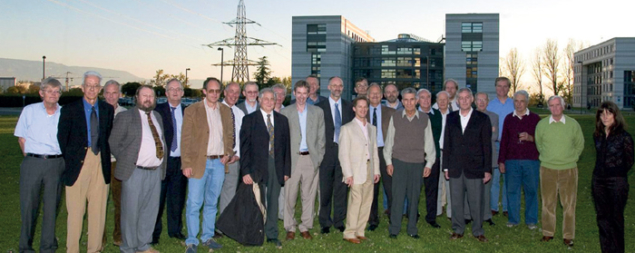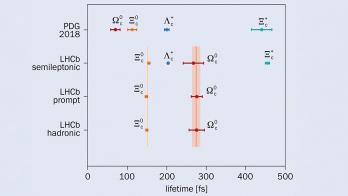Some background to an important result for the Standard Model.

Image credit: CERN-GE-0510038-01.
In 1973 – almost 10 years after the surprising discovery of CP violation – Makoto Kobayashi and Toshihide Maskawa produced the first theory of the phenomenon in the context of the Standard Model. They proposed a bold generalization of a mechanism that Sheldon Glashow, John Iliopoulos and Luciano Maiani had put forward in 1970. The “GIM mechanism” suppressed strangeness-changing weak neutral currents through the introduction of a fourth quark – charm – and was, in turn, an extension of ideas that began with Nicola Cabibbo. Kobayashi and Maskawa introduced a third generation of quarks (b and t), and a full 3 × 3 unitary matrix parameterizing complex couplings between the quark-mass eigenstates and the charged weak gauge bosons (W±). In this model, a single complex phase in the matrix accounted for all observed CP-violating effects in the kaon system, and provided for CP violation in matrix elements, both for mixing and for decays – that is, for both indirect and direct CP violation.
The discovery of the b quark in 1977 brought the theory of Kobayashi and Maskawa well and truly into the spotlight, and the hunt began to search for the predicted CP violation in the b-quark system (“What’s next for CP violation?”). In kaon physics, the crucial experimental question now was to disprove the superweak model for CP violation (“CP violation’s early days”), which had no need for direct CP violation. In contrast, in the Kobayashi-Maskawa model, the parameter describing direct CP violation, ε´, was nonzero. However, considerable theoretical uncertainty remained concerning its value, which was potentially too small to be measured by the existing experimental techniques. This provided fresh impetus to the search for direct CP violation, and prompted renewed efforts at CERN and at Fermilab to meet the experimental challenges involved.
At CERN, the NA31 experiment was proposed in 1982 with the explicit goal of establishing whether the ratio ε´/ε was nonzero. This required measuring all four decay rates of KS and KL to the charged and neutral 2π final states (see box). The concept behind NA31 was to measure KS and KL decays at the same locations (binned in momentum) to provide essentially the same acceptance for each set of events, and so reduce the dependence on Monte Carlo simulation. The experiment employed a mobile KS target, able to move along a 50-m track, with data-taking stations every 1.2 m. Additionally, beam and detector fluctuations were limited by rapidly alternating the data-taking between KS and KL. The experimental limitations were determined by statistics and background suppression. In both cases, a liquid argon calorimeter was used to achieve the stable, high-quality energy and position resolution that was crucial for reconstructing the π0π0 decays. The calorimeter was developed by exploiting the expertise acquired by the group of Bill Willis at CERN with the first liquid-argon calorimeter at the Intersecting Storage Rings.
In 1988, NA31 found the first evidence for direct CP violation, with a result that was about three standard deviations from zero. However, shortly after this the E731 experiment at Fermilab reported a measurement that was consistent with zero. These conflicting results increased the importance of answering the question on the existence of direct CP violation, and prompted the design of a new generation of detectors, both at CERN (NA48) and at Fermilab (KTeV).

Image credits, right to left: CERN-EX-9610003-07, CERN-EX-9610003-05, CERN-EX-9610003-04.
The NA48 experiment was designed to handle a 10-fold increase in beam intensity and event rates compared with NA31. It incorporated a magnetic spectrometer to reduce background in the charged-pion mode and a new calorimeter to replace the liquid-argon original. The novel liquid-krypton calorimeter was fully longitudinally integrating, and had fine granularity in two dimensions to provide faster detection with superior resolution for neutral-pion decays. Systematic effects were also greatly reduced in NA48 by observing all four decay modes concurrently.
In 1999, both the KTeV and NA48 experiments were successful in measuring direct CP violation in the decay of neutral kaons, clearly establishing that CP violation was not just confined to kaon mixing (CERN Courier September 1999 p32). The discovery was later recognized by honours in both Europe and the US. In 2005, the European Physical Society’s High-Energy Physics Prize was awarded jointly to CERN’s Heinrich Wahl, for his “outstanding leadership of challenging experiments on CP violation”, and to the NA31 collaboration as a whole, for having shown, for the first time, direct CP violation in the decays of neutral K mesons. Wahl, who was spokesman of NA31, had a long association with CP-violation experiments since his arrival at CERN in 1969, and was also a major proponent of NA48. Two years later, Italo Mannelli, Wahl and Bruce Winstein, leader of the KTeV collaboration, were awarded the W K H Panofsky prize of the American Physical Society, in recognition of their “leadership in the series of experiments that resulted in a multitude of precision measurements of properties of neutral K mesons, most notably the discovery of direct CP violation”.
During the past 50 years, the study of the neutral-kaon system has gone hand-in-hand with the development of the Standard Model
During the past 50 years, the study of the neutral-kaon system has gone hand-in-hand with the development of the Standard Model. In particular, CP violation in neutral kaons provided the experimental stimulus for Kobayashi and Maskawa to propose the third generation of quarks. That boosted the motivation to search for direct CP violation, which in turn motivated improvements in experimental techniques. The search for direct CP violation across several generations of experiments led to the tantalizing hint of a result in NA31, before the effect was eventually nailed down by KTeV and NA48.
Victor Hugo wrote in Les Misérables: “La symétrie, c’est l’ennui”. A less succinct but more poetic sentiment was expressed by Wolfenstein at the conference on CP violation at Chateau de Blois in 1989, which celebrated the 25th anniversary of the discovery of the unexpected effect. He described broken symmetry as “something more intriguing and perhaps more beautiful than perfect symmetry”. Another 25 years on, that sentiment is stronger than ever.
Measuring direct CP violation in the neutral-kaon system
CP violation in general manifests itself as a difference between the behaviours of particles and antiparticles (apart from the obvious charge inversion). In the original experiment at Brookhaven, the observation of the decay of a KL to two pions could be explained by one effect or by a combination of two effects:
• The KL is an exact eigenstate of CP with eigenvalue –1. Its decay is mediated by an interaction that violates CP, allowing it to decay to a CP = +1 final state (e.g. two pions). Such direct CP violation is parameterized by a complex quantity, ε´.
• The KL eigenstate is an admixture of CP = –1 and CP = +1 components, the CP = +1 part being a (complex) fraction ε of the total. This is the case if the mixing amplitude (which causes transitions between K0 and K0) violates CP. This is called indirect CP violation.
The parameter ε measures the admixture of the CP = +1 eigenstate in the KL mass eigenstate, so if this were the only source of CP violation, the fraction of KL decays with a two-pion final state normalized to Kswould be independent of whether the two pions were π+π–or a π0π0. Any observed difference between the amplitude ratios η+– and η00would be evidence for direct CP violation, and the deviation from unity of their squared-ratio (which depends on the respective event rates) can be shown to be six times the real part of ε´/ε. This is given experimentally by the ratio-of-ratios of event rates. Therefore, to make a measurement of the direct CP violation parameter, the four rates must be measured. Because ε´/ε is of the order of 10–3, the measurements are particularly difficult.








